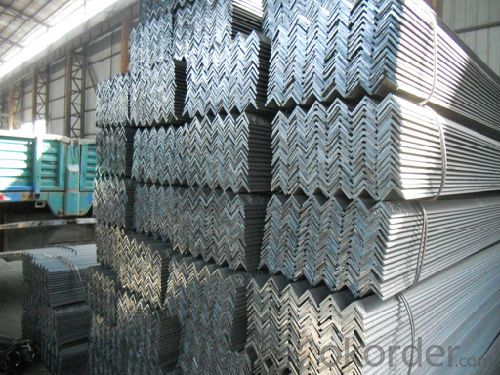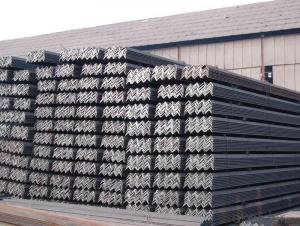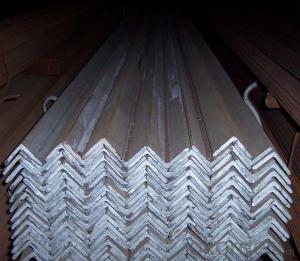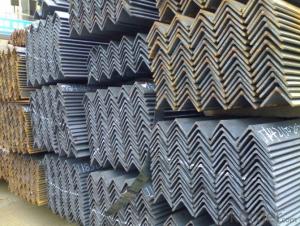SS540 Material Angle Steel High Quality
- Loading Port:
- Tianjin
- Payment Terms:
- TT or LC
- Min Order Qty:
- 25 m.t.
- Supply Capability:
- 2000 m.t./month
OKorder Service Pledge
OKorder Financial Service
You Might Also Like
Product Description:
OKorder is offering Angle Steel great prices with worldwide shipping. Our supplier is a world-class manufacturer of steel, with our products utilized the world over. OKorder annually supplies products to European, North American and Asian markets. We provide quotations within 24 hours of receiving an inquiry and guarantee competitive prices.
Product Applications:
According to the needs of different structures, Angle can compose to different force support component, and also can be the connections between components. It is widely used in various building structures and engineering structures such as roof beams, bridges, transmission towers, hoisting machinery and transport machinery, ships, industrial furnaces, reaction tower, container frame and warehouse etc.
Product Advantages:
OKorder's Angle Steelare durable, strong, and resist corrosion.
Main Product Features:
· Premium quality
· Prompt delivery & seaworthy packing (30 days after receiving deposit)
· Corrosion resistance
· Can be recycled and reused
· Mill test certification
· Professional Service
· Competitive pricing
Product Specifications:
1. Invoicing on theoretical weight or actual weight as customer request
2. Length: 6m, 9m, 12m as following table
3. Sizes
Sizes: 25mm-250mm | ||
a*t | ||
25*2.5-4.0 | 70*6.0-9.0 | 130*9.0-15 |
30*2.5-6.6 | 75*6.0-9.0 | 140*10-14 |
36*3.0-5.0 | 80*5.0-10 | 150*10-20 |
38*2.3-6.0 | 90*7.0-10 | 160*10-16 |
40*3.0-5.0 | 100*6.0-12 | 175*12-15 |
45*4.0-6.0 | 110*8.0-10 | 180*12-18 |
50*4.0-6.0 | 120*6.0-15 | 200*14-25 |
60*4.0-8.0 | 125*8.0-14 | 250*25 |
Packaging & Delivery of Angle Steel
1. Packing: it is nude packed in bundles by steel wire rod
2. Bundle weight: not more than 3.5MT for bulk vessel; less than 3 MT for container load
3. Marks:
Color marking: There will be color marking on both end of the bundle for the cargo delivered by bulk vessel. That makes it easily to distinguish at the destination port.
Tag mark: there will be tag mark tied up on the bundles. The information usually including supplier logo and name, product name, made in China, shipping marks and other information request by the customer.
If loading by container the marking is not needed, but we will prepare it as customer request.
FAQ:
Q1: Why buy Materials & Equipment from OKorder.com?
A1: All products offered byOKorder.com are carefully selected from China's most reliable manufacturing enterprises. Through its ISO certifications, OKorder.com adheres to the highest standards and a commitment to supply chain safety and customer satisfaction.
Q2 What makes stainless steel stainless?
A2 Stainless steel must contain at least 10.5 % chromium. It is this element that reacts with the oxygen in the air to form a complex chrome-oxide surface layer that is invisible but strong enough to prevent further oxygen from "staining" (rusting) the surface. Higher levels of chromium and the addition of other alloying elements such as nickel and molybdenum enhance this surface layer and improve the corrosion resistance of the stainless material.
Q3 Can stainless steel rust?
A3 Stainless does not "rust" as you think of regular steel rusting with a red oxide on the surface that flakes off. If you see red rust it is probably due to some iron particles that have contaminated the surface of the stainless steel and it is these iron particles that are rusting. Look at the source of the rusting and see if you can remove it from the surface.
Images:


- Q:Can steel angles be painted?
- Yes, steel angles can be painted. The process of painting steel angles involves cleaning the surface, applying a primer, and then applying the desired paint. The primer helps to create a smooth and even surface for the paint to adhere to, while also providing additional protection against corrosion. Once the primer is dry, the paint can be applied using a brush, roller, or spray gun. It is important to choose a paint that is specifically designed for metal surfaces to ensure proper adhesion and durability. Overall, painting steel angles is a common practice to enhance their appearance and provide additional protection against rust and corrosion.
- Q:How do you prevent steel angles from vibrating under dynamic loads?
- One possible way to prevent steel angles from vibrating under dynamic loads is by using damping techniques. Damping involves adding materials or structures that absorb or dissipate the energy generated by the vibrating steel angles. This can be achieved by attaching damping pads or strips made of viscoelastic materials to the steel angles, which help absorb and dissipate the vibration energy. Another approach is to incorporate dampers such as tuned mass dampers or friction dampers, which are designed to reduce vibrations by adding additional mass or introducing friction forces to counteract the dynamic loads. Proper design and reinforcement of the steel angles can also help to increase their stiffness and reduce the likelihood of vibration.
- Q:What are the different methods of surface finishing for steel angles?
- Steel angles can be finished using various methods, each with its own advantages and considerations. Painting, galvanizing, powder coating, and shot blasting are the most commonly used methods. When it comes to surface finishing steel angles, painting is a popular choice. It not only protects against corrosion but also adds an appealing look. Typically, the angle is cleaned and primed before multiple coats of paint are applied. This method allows for a wide range of colors and easy touch-ups in case of damage. Galvanizing, on the other hand, involves coating the steel angle with zinc to safeguard it from corrosion. This method is particularly effective in harsh environments where moisture or chemicals may be present. The most common technique is hot-dip galvanizing, wherein the angle is immersed in molten zinc. This creates a durable finish that requires minimal maintenance. Another widely used method is powder coating, which entails applying a dry powder to the angle and then curing it with heat. This forms a protective layer that offers excellent durability and resistance to corrosion, chemicals, and UV rays. Powder coating also provides a smooth and consistent finish, with a wide array of color options. For a mechanical surface finishing approach, shot blasting is employed. This method involves blasting the steel angle with high-speed abrasive particles to remove rust, mill scale, or other contaminants. It results in a clean and smooth finish while creating a rough texture that enhances paint adhesion. Shot blasting is often used as a pre-treatment before painting or powder coating. When selecting a surface finishing method for steel angles, it is crucial to consider the specific requirements of their application. Factors such as the environment, expected lifespan, aesthetic preferences, and budget should all be taken into account. Seeking guidance from professionals or the steel manufacturer can help determine the most suitable surface finishing method for steel angles in a given situation.
- Q:Can steel angles be used as lintels or beams in construction?
- Yes, steel angles can be used as lintels or beams in construction. Steel angles are versatile structural elements that can provide support and strength to various types of structures. They are commonly used in construction projects for their ability to bear heavy loads and resist bending or warping. When used as lintels, steel angles are typically installed horizontally above doors and windows to distribute the weight of the structure above and prevent the opening from sagging. As beams, steel angles can be used to support floors, roofs, or other structural components. They are often preferred for their durability, versatility, and cost-effectiveness compared to other materials. However, it is important to consult with a structural engineer or construction professional to ensure that the specific steel angles being used are suitable for the intended application and meet the required building codes and standards.
- Q:Can steel angles be used for load-bearing walls?
- Yes, steel angles can be used for load-bearing walls. Steel angles are commonly used in construction as a structural element to provide support and stability. They are often used to reinforce load-bearing walls by adding strength and rigidity. Steel angles can be used to distribute the weight of a load evenly, making them suitable for load-bearing applications. However, it is important to ensure that the steel angles are appropriately designed and installed to meet the specific load requirements of the wall. Consulting with a structural engineer or construction professional is recommended to ensure the proper use of steel angles for load-bearing walls.
- Q:What are the environmental impact considerations of using steel angles?
- The environmental impact of using steel angles must be taken into account across various industries. One crucial factor to consider is the extraction and processing of iron ore for steel production. The mining process can cause significant harm to the environment, including the destruction of habitats, erosion of soil, and pollution of water sources. Furthermore, the extraction process requires a substantial amount of energy, which contributes to the release of greenhouse gases and air pollution. Moreover, the production of steel involves the utilization of coal and other fossil fuels, which also emit greenhouse gases. The combustion of these fuels releases carbon dioxide and other harmful substances, resulting in climate change and air pollution. The production of steel also generates a considerable amount of waste, including slag and other byproducts. It is essential to dispose of and manage these waste materials properly to minimize their impact on the environment. The transportation and logistics of steel products also contribute to the environmental impact. When steel products are transported from manufacturing facilities to construction sites or other end-users, carbon emissions can occur, especially for long-distance journeys. Nevertheless, it is important to note that steel is a highly durable material with a long lifespan. This longevity can help offset some of the environmental impacts associated with its production and transportation. To minimize the environmental impact of using steel angles, several strategies can be implemented. Firstly, incorporating recycled steel reduces the need for new iron ore extraction and decreases energy consumption and emissions. Utilizing recycled content in steel production is an effective method to reduce the environmental footprint. Additionally, improving energy efficiency in steel manufacturing processes can help lower greenhouse gas emissions. Adopting cleaner technologies, such as electric arc furnaces, can significantly reduce carbon emissions compared to traditional blast furnace methods. Furthermore, sustainable transportation practices, such as utilizing efficient shipping methods or promoting local sourcing, can help decrease the carbon footprint associated with the transportation of steel angles. Overall, although the use of steel angles poses environmental impact considerations, implementing sustainable practices can mitigate these impacts and contribute to a more environmentally friendly industry.
- Q:How do you determine the deflection of a steel angle?
- To determine the deflection of a steel angle, you need to consider various factors such as the material properties of the steel, the dimensions of the angle, and the applied load. The deflection of a steel angle can be determined using mathematical equations and formulas, specifically those related to structural mechanics. Firstly, you need to determine the moment of inertia (I) of the steel angle, which depends on its cross-sectional shape and dimensions. The moment of inertia represents the resistance of the angle to bending and is a crucial parameter in calculating deflection. The moment of inertia can be obtained from engineering handbooks or calculated using mathematical formulas specific to the shape of the angle. Next, you need to determine the load that is applied to the steel angle. This load can be in the form of a concentrated force, a distributed load, or a combination of both. The magnitude and distribution of the load will influence the deflection of the angle. Once you have determined the moment of inertia and the applied load, you can use the appropriate deflection equation or formula to calculate the deflection of the steel angle. The specific equation used will depend on the type of loading and the boundary conditions of the angle (e.g., whether it is simply supported or fixed at both ends). For example, if the steel angle is subjected to a concentrated load at its midpoint and is simply supported, you can use the equation for deflection of a simply supported beam under a concentrated load. This equation relates the deflection (δ) to the applied load (F), the length of the angle (L), the moment of inertia (I), and other relevant constants. It is important to note that the deflection calculated using these equations is an approximation and does not take into account factors such as material imperfections, fabrication tolerances, or the effects of dynamic loading. Therefore, it is always advisable to consult relevant design codes, standards, or engineering handbooks to ensure accurate and safe design practices when determining the deflection of a steel angle.
- Q:What are the different types of corrosion that can affect steel angles?
- Steel angles can be affected by various types of corrosion, including: 1. Uniform corrosion: This common type of corrosion evenly deteriorates the entire surface of the steel angle. It usually occurs due to exposure to moisture and oxygen in the surrounding environment. 2. Pitting corrosion: Characterized by the formation of small pits or holes on the steel angle's surface, this type of corrosion happens when localized areas of the metal come into contact with more aggressive corrosive agents, such as chloride ions or acidic substances. 3. Galvanic corrosion: When two different metals are exposed to an electrolyte like water or saltwater, galvanic corrosion takes place. In this process, the more active metal (anode) corrodes while the less active metal (cathode) remains protected. 4. Crevice corrosion: Confined spaces or crevices where stagnant water or moisture accumulates can lead to crevice corrosion. The lack of oxygen and the concentration of corrosive agents can cause localized corrosion and degradation of the steel angle. 5. Filiform corrosion: This type of corrosion manifests as thread-like filaments on the steel angle's surface. It is typically triggered by the presence of moisture, oxygen, and contaminants like salts or organic compounds. 6. Stress corrosion cracking: Stress corrosion cracking occurs when a combination of tensile stress and a corrosive environment causes cracks to develop in the steel angle. This type of corrosion is particularly dangerous as it can result in sudden and catastrophic failure of the structure. It is important to acknowledge that the severity and probability of each corrosion type can vary depending on factors such as the environment, exposure to corrosive agents, and the quality of the steel angle. Regular inspections, maintenance, and appropriate protective coatings can help mitigate the impact of corrosion on steel angles.
- Q:What are the different tolerances for steel angles?
- The different tolerances for steel angles depend on the specific manufacturing standards and specifications. Generally, the tolerances for steel angles are determined by the governing bodies or organizations that set industry standards, such as the American Society for Testing and Materials (ASTM) or the International Organization for Standardization (ISO). The tolerances for steel angles can vary based on factors such as the angle's dimensions, shape, and intended application. These tolerances ensure that the angles meet the required dimensional and geometric specifications, allowing them to be used effectively in various structural or engineering applications. Some common tolerances for steel angles include: 1. Dimensional Tolerances: These tolerances define the allowable variations in length, width, and thickness of the angle. For example, a 90-degree angle might have a tolerance of +/- 1/8 inch in its leg length or a maximum deviation of 2 degrees from the specified angle. 2. Straightness Tolerances: This tolerance measures the allowable deviation from a straight line along the length of the angle. It ensures that the angle does not have excessive bends or twists, which may affect its structural integrity. 3. Surface Finish Tolerances: These tolerances specify the acceptable variations in the surface finish of the angle, such as roughness or surface irregularities. They ensure that the angle meets the required aesthetic and functional standards. 4. Squareness Tolerances: Squareness tolerance measures the maximum allowable deviation from a perfect right angle for angles that are specified to be 90 degrees. It ensures that the angle maintains its intended shape and can be properly joined or connected to other components. 5. Weight Tolerances: These tolerances define the acceptable variations in the weight of the steel angle. They ensure that the angle meets the specified weight requirements, which may be crucial in applications where weight distribution plays a role. It is important to note that the specific tolerances for steel angles may vary depending on the region, industry, or project requirements. Therefore, it is essential to consult the relevant standards or specifications to determine the appropriate tolerances for a specific steel angle.
- Q:What does "angle length" and "limb width" mean?
- The width of a limb refers to the width of the point to the edge of the angle, and the length of the limb corresponds to the length of the edge;Angle called angle, the steel strip is perpendicular to each other on both sides into the corner. There are equal angles and unequal angles. The two sides of an equal angle steel are equal in width. The specifications are expressed in millimeters of edge width * edge width * edge thickness. Such as "/ 30 x 30 x 3", that is 30 mm width equal angle, edge thickness of 3 mm.
1. Manufacturer Overview |
|
|---|---|
| Location | |
| Year Established | |
| Annual Output Value | |
| Main Markets | |
| Company Certifications | |
2. Manufacturer Certificates |
|
|---|---|
| a) Certification Name | |
| Range | |
| Reference | |
| Validity Period | |
3. Manufacturer Capability |
|
|---|---|
| a)Trade Capacity | |
| Nearest Port | |
| Export Percentage | |
| No.of Employees in Trade Department | |
| Language Spoken: | |
| b)Factory Information | |
| Factory Size: | |
| No. of Production Lines | |
| Contract Manufacturing | |
| Product Price Range | |
Send your message to us
SS540 Material Angle Steel High Quality
- Loading Port:
- Tianjin
- Payment Terms:
- TT or LC
- Min Order Qty:
- 25 m.t.
- Supply Capability:
- 2000 m.t./month
OKorder Service Pledge
OKorder Financial Service
Similar products
New products
Hot products
Related keywords



























